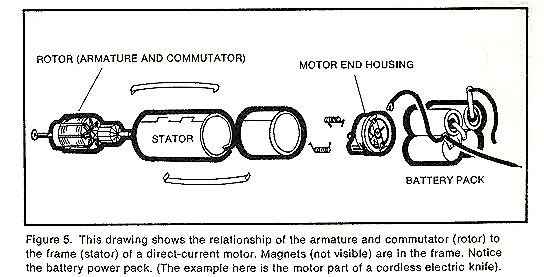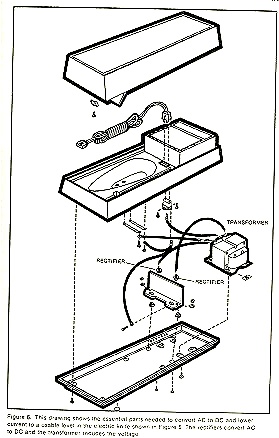The direct current (DC) motor looks and acts almost like an AC-DC universal motor . It has an armature, commutator, and brushes . However, it can operate on direct current only on current which flows always in the same direction.
One of the main differences between an AC-DC universal motor and a DC motor is that most DC motors have stators consisting of a series of permanent magnets rather than field coils. This creates a magnetic field, just as field coils do, so the rotor can revolve. However, the voltage needed to get the rotor of a DC motor revolving is much lower (5 to 7 volts) than that needed by an AC-DC universal motor (115 volts).
Consider the appliances in which a DC motor is used-electric knives, electric toothbrushes, and electric shavers. These are all units which do not need a great deal of power to do work. For this reason, a DC motor provides much less torque than a universal motor.
In addition, the fact that many electric knives, shavers, and tooth brushes are “cordless” demands that the units be capable of working on battery power (Figure 5). As you know, a battery pack provides relatively low voltage.
A direct-current (DC) motor may “work” on alternating current (AC). How can this be? Some models of electric knives, toothbrushes, and shavers can be plugged into an AC wall outlet and will operate. However, the appliance is not actually functioning on alternating current.

Figure 5. This drawing shows the relationship of the armature and commutator (rotor) to the frame (stator) of a direct-current motor. Magnets (not visible) are in the frame. Notice the battery power pack. (The example here is t he motor part of a cordless electric knife) .
The alternating current is being transformed into direct current by a part inside the appliance called a rectifier (Figure 6). The same thing happens in about the same way inside the alternator of your car. The alternator actually produces alternating current, but it is converted to direct current by mechanisms called diodes. The lights, radio, and all other accessories in your car need direct current to work.
Inside the DC motor of an electric knife, shaver, and toothbrush is an other feature that works like a transformer operating in reverse. Rather than stepping up the voltage, voltage drops, so the appliance can operate at its normal energy level of 5 to 7 volts when plugged into the wall. At a greater voltage, the unit may be damaged.

Figure 6. This drawing shows the essential parts needed to convert AC to DC and lower current to a usable level in the electric knife shown in Figure 5. The rectifiers convert AC to DC and the transformer reduces the voltage .